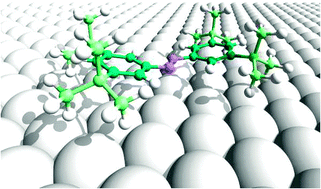We present large-scale density-functional theory (DFT) calculations and temperature programmed desorption measurements to characterize the structural, energetic and vibrational properties of the functionalized molecular switch 3,3′,5,5′-tetra-tert-butyl-azobenzene (TBA) adsorbed at Au(111). Particular emphasis is placed on exploring the accuracy of the semi-empirical dispersion correction approach to semi-local DFT (DFT-D) in accounting for the substantial van der Waals component in the surface bonding. In line with previous findings for benzene and pure azobenzene at coinage metal surfaces, DFT-D significantly overbinds the molecule, but seems to yield an accurate adsorption geometry as far as can be judged from the experimental data. Comparing the trans adsorption geometry of TBA and azobenzene at Au(111) reveals a remarkable insensitivity of the structural and vibrational properties of the –N![[double bond, length as m-dash]](https://www.rsc.org/images/entities/char_e001.gif) N– moiety. This questions the established view of the role of the bulky tert-butyl-spacer groups for the switching of TBA in terms of a mere geometric decoupling of the photochemically active diazo-bridge from the gold substrate.
N– moiety. This questions the established view of the role of the bulky tert-butyl-spacer groups for the switching of TBA in terms of a mere geometric decoupling of the photochemically active diazo-bridge from the gold substrate.

You have access to this article
 Please wait while we load your content...
Something went wrong. Try again?
Please wait while we load your content...
Something went wrong. Try again?
![[double bond, length as m-dash]](https://www.rsc.org/images/entities/char_e001.gif) N– moiety. This questions the established view of the role of the bulky
N– moiety. This questions the established view of the role of the bulky 

 Please wait while we load your content...
Please wait while we load your content...